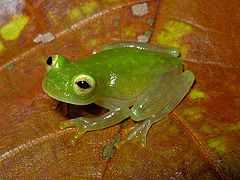Fleischmann's Glass Frog
| Fleischmann's Glass Frog | |
|---|---|
 | |
| Conservation status | |
| Scientific classification | |
| Kingdom: | Animalia |
| Phylum: | Chordata |
| Class: | Amphibia |
| Order: | Anura |
| Family: | Centrolenidae |
| Genus: | Hyalinobatrachium |
| Species: | H. fleischmanni |
| Binomial name | |
| Hyalinobatrachium fleischmanni (Boettger, 1893) | |
| Synonyms | |
| |
The Fleischmann's Glass Frog (Hyalinobatrachium fleischmanni) is a species of frog in the Centrolenidae family. It is found in Belize, Colombia, Costa Rica, El Salvador, Guatemala, Guyana, Honduras, Mexico, Nicaragua, Venezuela, Panama, the Guianas, and Suriname. Its natural habitats are subtropical or tropical moist lowland forests, subtropical or tropical moist montane forests, rivers, and heavily degraded former forest. It is threatened by habitat loss.
Habitat
Fleischmann's Glass Frogs live near fast streams. In Costa Rica, these frogs live in lowland wet forests, rain forests, and even in higher elevations. They do not like dry areas such as the northwestern lowlands, high mountains, or coasts. Of all the glass frogs in Costa Rica, Fleischmann's glass frogs are the most populous.[1]
Physical Description
Glass frogs have similarities to tree frogs. They look very lose to the naked eye except glass frog's eyes point forward and are golden. During the day, these frogs camouflage themselves under leaves but above water. Male glass frogs are 19-28 mm long while females measure from 23-32 mm long. They have a green semi-translucent color with yellow translucent hands. Their skin has dots which matches that of the leaves in the area. When confronted or approached, they tend to freeze up and not move. It is not specifically known what the glass frog eats, but it is assumed that they feed on small insects.[1]
History
There have been more than 100 reported glass frogs throughout Central and South America. 13 species can be found in Costa Rica. Adults tend to be more active during the night when there is rain to keep their skin moist and from drying out. However, strong rains can kill them because their bodies are so fragile. A simple direct shot from a raindrop has been known to kill a glass frog.[1]
References
- ↑ 1.0 1.1 1.2 "Glass Frog, Costa Rica- information, where to see it, and photos". Anywhere Costa Rica. Retrieved 29 March 2013.
Sources
- Coloma, L.A., Ron, S., Wild, E., Cisneros-Heredia, D., Solís, F., Ibáñez, R. & Santos-Barrera, G. 2004. Hyalinobatrachium fleischmanni. 2006 IUCN Red List of Threatened Species. Downloaded on 21 July 2007.
